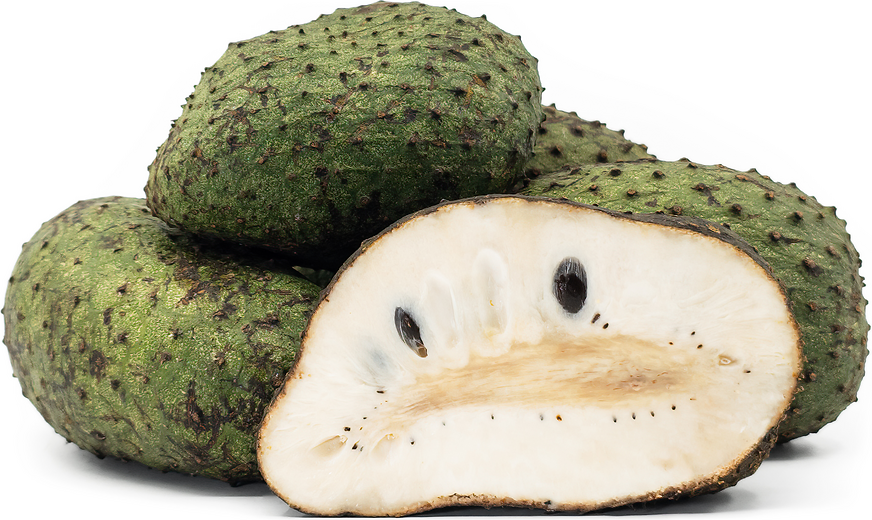Soursop Nutrition Facts – Soursop fruit is native to Central and South American nations and resembles a hybrid between a strawberry and an apple with thorns. Succulents are sometimes described as a mix of strawberries and pineapples in their flavour. It belongs to the custard apple family, including the Annona muricata broadleaf evergreen fruit. Lowering inflammation and boosting the immune system are only two of its many health benefits.

Contents
How Many Calories Are In Soursop?
- Calories: 149
- Fat: 0.7g
- Sodium: 31.5mg
- Carbohydrates: 37.9g
- Fibre: 7.4g
- Sugars: 30.5g
- Protein: 2.3g
- Vitamin C: 46.4mg
- Potassium: 626mg
Here is the detailed chart for soursop nutrition facts for better understanding.
- Soursop has a carbohydrate content of around 38 grams per cup. Sourop’s carbohydrates are derived from sugars found in the fruit, and each serving provides almost 7 grams of fibre (about a quarter of your recommended daily intake). Soursop has a low GI (glycaemic load).
- A serving of this fruit has less than a gram of fat, making it an excellent source of fibre.
- The protein content of soursop, like that of most fruits, is low. Because of this, you’ll need to consume salmon, lean meats, and legumes to achieve your daily protein requirements.
- There are a lot of micronutrients in soursop. Vitamin C is found in 46.4 mg in one cup. It also contains 626 mg of potassium, which helps regulate blood pressure and speed up recovery after a workout.
- Soursop is a good source of carbohydrates, vitamin C, potassium, and fibre.
- Soursop fruit and tree bark, roots, and leaves might be used to treat cancer and other non-malignant disorders, according to research published in 2018. This assertion is, however, unfounded by human data. According to Cancer Treatment Centers of America, soursop has been linked to various baseless claims about its ability to treat and prevent cancer. Using soursop plant chemicals to develop new medicines is more effective than merely eating the fruit or drinking tea prepared from its leaves.
- Soursop has a lot of fibre, which may help digestion. As a diuretic and laxative, the fruit juice may help flush out excess salt from the system. Gastric ulcers may be treated using an extract of soursop.
- Like other fruits and vegetables, Soursop is a vital source of antioxidants, which may aid in the repair of damaged cells and the reduction of inflammation.
- A soursop allergy has never been recorded in the medical literature. However, any protein-rich diet may conceivably cause an allergic reaction.

Some Lesser Known Soursop Nutrition Facts
- Graviola, which is found in soursop, has reduced blood sugar levels in research rats.
- Graviola’s chemicals have been demonstrated to produce movement abnormalities and myeloneuropathy in experimental animals, a condition with symptoms comparable to Parkinson’s Disease.
- Soursop may be grown in “sweet” and “sour” varieties. The leaves of the soursop tree are used to make soursop tea.
- Central and South America are the primary markets for this exotic fruit. There are, however, certain supermarkets that sell frozen soursop.
- Cherimoya has a flavour and nutritional profile similar to those of soursop, another member of the custard apple family. On the other hand, Cherimoya lacks soursop’s cancer-fighting and anti-inflammatory qualities.
- Blending equal amounts of strawberries, pineapple, and bananas creates the taste profile of soursop if you can’t get cherimoya or soursop.
- Soursop is only found in the tropics. Thus you won’t be able to locate it in North America. On its own, if the fruit can be found, it may be eaten in the same way as any other piece of raw fruit. Also, soursop may be used to make a variety of sweets, including syrups, smoothies, and ice creams, as well as candies and sweet drinks.
- Soursop, a prominent element in South American cuisine, may be found in anything from juices to ice creams and sorbets. Smoothies, tea, and even baked products may be created using fruit juice and meat if you so want.
- On the other hand, Soursop is most often eaten raw because of its naturally sweet taste. Remove the rind and scoop out the meat before serving. Be aware that soursop seeds contain annonacin, which has been demonstrated to be a neurotoxin that may have a role in Parkinson’s disease.
- This fruit’s potential health advantages have been identified via soursop extract in both human and animal experiments. Although these studies are looking at the effects of a concentrated dosage of soursop extract, it is crucial to realize that the quantity you would receive from a single serving is far more in these studies.
- If you’re looking for something to add to your diet that is both tasty and nutritious, soursop is an excellent choice.
- Soursop pulp may be used to produce delicious and healthful juices and smoothies; they can also be used as an ice cream flavour.
Summary
In conclusion, soursop is a fruit that is known for its sweet and tangy flavor. It is rich in various essential nutrients such as vitamin C, fiber, and antioxidants, which can offer various health benefits. Understanding soursop nutrition facts can help you make informed dietary choices, ensuring you get the maximum health benefits from consuming this delicious fruit.
